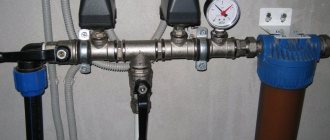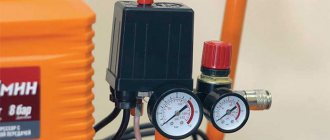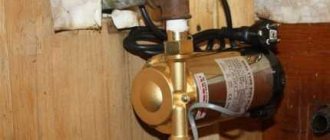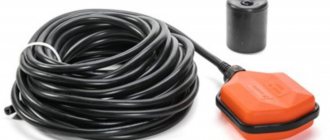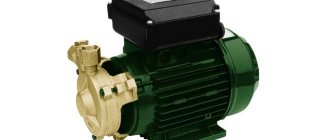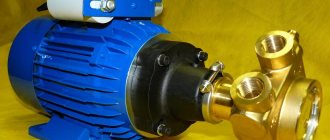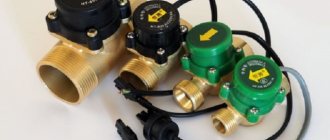The water supply system of a private house is impossible without a pump. But you have to somehow turn it on and off, and make sure that it doesn’t work in the absence of water. A water pressure switch is responsible for turning the pump on and off, and the presence of water should be monitored by protection against dry running of the pump.
No matter where the pump pumps water from, at times a situation arises that the water has run out - if the flow rate of a well or borehole is small, you can simply pump out all the water. If water is pumped from a centralized water supply, its supply may simply be stopped. The operation of the pump in the absence of water is called dry running.
What is dry running of a pump?
No matter where the pump pumps water from, at times a situation arises that the water has run out - if the flow rate of a well or borehole is small, you can simply pump out all the water. If water is pumped from a centralized water supply, its supply may simply be stopped. The operation of the pump in the absence of water is called dry running. The term “idling” is sometimes used, although this is not entirely correct.
In order for the water supply at home to work normally, you need not only a pump, but also a dry water protection system and automatic on-off switching.
What's wrong with dry running, other than wasting electricity? If the pump operates in the absence of water, it will overheat and burn out - the pumped water is used to cool it. No water - no cooling. The engine will overheat and burn out. Therefore, protection against dry running of the pump is one of the components of the automation that will have to be purchased in addition. There are, however, models with built-in protection, but they are expensive. It is cheaper to buy additional automation.
Supply voltage and overloads must be monitored
The electric motor is the most important structural component of a well pump. Its power supply parameters that meet factory requirements will contribute to long-term and trouble-free operation of all units of the unit.
From the influence of negative factors of the electrical network (current surges, voltage surges), you can reliably protect a submersible pump, namely its motor, using voltage stabilizers or motor protection relays (automatic machines). Currently, models of such protective devices from both foreign and domestic manufacturers are available on the market.
Overload of the pump motor is prevented by inexpensive but important parts of the system - thermal current relays.
How can you protect the pump from dry running?
There are several different devices that will turn off the pump if there is no water:
- dry running protection relay;
- water flow control devices;
- water level sensors (float switch and level control relay).
All these devices are designed for one thing - turn off the pump when there is no water. They just work differently and have different areas of application. Next, we will look at the features of their work and when they are most effective.
DIY installation
The pressure switch, according to buyers, is best installed directly at the outlet (on the hydraulic accumulator). In this area, there is a significant leveling of flow turbulence and pressure surges during normal operation of the pump and during its startup. Also among the common mistakes when choosing a device is the lack of due attention to the recommendations of the manufacturer itself regarding the performance qualities of branded equipment.
The main limitations are related to the microclimate. Most popular models function normally at temperatures of +4° and above, as well as humidity of 65% or less. Such equipment must be installed in well-heated rooms. Before installing pumping equipment control sensors, you should install the following elements yourself (most of them are installed during the construction stage):
New products in the field of relays are equipped with special fittings that facilitate the process of connecting the structure to other elements of the system. Some budget models can be installed in a block with a pump. Units that have appropriate protection from water can be installed in a well, caisson or with a pump. Description and equipment will depend on the selected model.
In addition to the main selection criteria, it is recommended to pay attention to the optimal humidity and temperature coefficient for the operation of the structure, which has a huge impact on the device, its service life and performance.
Dry running protection relay
A simple electromechanical device monitors the presence of pressure in the system. As soon as the pressure drops below the threshold, the power supply circuit is broken and the pump stops working.
The relay consists of a membrane that responds to pressure and a contact group that is normally open. When the pressure decreases, the membrane presses on the contacts, they close, turning off the power.
This is what protection against dry running of the pump looks like
When is it effective?
The pressure to which the device responds is from 0.1 atm to 0.6 atm (depending on factory settings). This situation is possible when there is little or no water, the filter is clogged, or the self-priming part is too high. In any case, this is a dry running condition and the pump must be turned off, which is what happens.
Electrical connection diagram for a dry running relay in a system with a hydraulic accumulator
An idle speed protection relay is installed on the surface, although there are models in a sealed housing. It works normally in an irrigation scheme or any system without a hydraulic accumulator. It works more efficiently with surface pumps when a check valve is installed after the pump.
When it does not guarantee shutdown in the absence of water
You can install it in a system with HA, but you will not get 100% protection against dry running of the pump. It's all about the particular structure and operation of such a system. Place a protective relay in front of the water pressure switch and the hydraulic accumulator. In this case, there is usually a check valve between the pump and the protection, that is, the membrane is under pressure created by the hydraulic accumulator. This is a common scheme. But with this method of switching on, it is possible that a working pump in the absence of water will not turn off and will burn out.
A more detailed diagram of connecting a pressure switch in a water supply circuit with a deep pump
For example, a dry running situation has been created: the pump is turned on, there is no water in the well/borehole/tank, and there is some water in the accumulator. Since the lower pressure threshold is usually set to about 1.4-1.6 atm, the protective relay membrane will not work. After all, there is pressure in the system. In this position, the membrane is pressed out, the pump will run dry.
It will stop either when it burns out or when most of the water supply is used up from the hydraulic accumulator. Only then will the pressure drop to critical and the relay will be able to operate. If such a situation arose during the active use of water, nothing terrible will happen in principle - several tens of liters will dry up quickly and everything will be normal. But if this happened at night, they flushed the water in the tank, washed their hands and went to bed. The pump turned on, but there was no signal to turn off. By the morning, when water collection begins, it will be inoperative. That is why in systems with hydraulic accumulators or pumping stations it is better to use other devices to protect against dry running of the water pump.
Float switch
A float switch is the simplest and cheapest way to protect the circulation pump from overheating and damage when running dry. The advantage of the device is that it can be used as a working medium level sensor and as an actuator.
They install switches in tanks, wells, reservoirs and use them to control household and industrial pumps in water supply and sewer lines. The required level of switch operation is determined by the length of the cable.
Several float switches can be placed in one container, each of which will perform a separate function to control the main or backup pump equipment.
Dry-running float sensors come in light and heavy sizes. The former are used for supplying and draining water, the latter - in sewers and drainage pipelines.
Float switch MS-1
For correct operation of the device, a minimum well diameter of 40 cm is required. This feature does not allow float switches to be considered a universal means of protecting the pump from running dry.
Safety pressure switch
The device is a conventional pressure switch, equipped with additional protection against idling when the pressure drops below factory settings.
This pressure switch controls the switching on and off of a surface or well pump if the pipeline diagram includes a hydraulic accumulator or a connection to an automatic pumping station is provided. The relay operates at 0.4-0.6 atmospheres. This parameter is set at the factory and cannot be changed.
If pressure fluctuations inside the pipeline are within specified limits, then the pressure switch does not operate and the pump operates normally. When the pressure drops to the set values, which happens in the absence of water, the dry running sensor is activated, the contacts supplying the circuit are opened, and the device for pressure movement of liquid is turned off.
Connection diagram for a water pressure switch to a deep pump
The process of starting the pump is carried out only manually by pressing the lever. Before this, the cause of the engine stopping is determined and eliminated. A prerequisite during startup is to fill the pump with water.
Which protective device should you choose?
The choice of a device to protect the pump from dry running is determined by the model of the pump itself and the tasks it needs to cope with. The optimal option is to use a dry-running sensor for the pump in the form of a float and a pressure switch. Connecting these devices to the pipeline will completely reduce the risk of pump equipment breakdown.
The use of protective elements is not necessary if:
- the depth of the well or container is sufficiently large;
- servicing of the pumping unit is carried out by an experienced technician;
- The water level in the system does not change - there is no point in connecting with protection devices.
The operation of the pump requires increased attention: as soon as the water disappears or the thermal relay is triggered and the engine is turned off, you should immediately find out the cause and eliminate it, and only then resume the operation of the pump unit.
Water flow control devices
In any situation that causes the pump to run dry, there is insufficient or no water flow. There are devices that monitor this situation - relays and water flow controllers. Flow relays or sensors are electromechanical devices, controllers are electronic.
Flow relays (sensors)
There are two types of flow sensors - petal and turbine. Petal has a flexible plate that is located in the pipeline. In the absence of water flow, the plate deviates from its normal state, contacts are activated, turning off the power to the pump.
This is what petal flow sensors look like
Petal sensor device
Turbine water flow sensor device
Water flow sensor for plumbing
Types and parameters of water flow sensors for the pump
Turbine flow sensors are somewhat more complicated. The basis of the device is a small turbine with an electromagnet in the rotor. When there is a flow of water or gas, the turbine rotates, creating an electromagnetic field, which is converted into electromagnetic pulses read by the sensor. This sensor, depending on the number of pulses, turns on/off the power to the pump.
Flow controllers
Basically, these are devices that combine two functions: dry-running protection and a water pressure switch. In addition to these features, some models may have a built-in pressure gauge and check valve. These devices are also called electronic pressure switches. These devices cannot be called cheap, but they provide high-quality protection, serving several parameters at once, ensuring the required pressure in the system, turning off the equipment when there is insufficient water flow.
| Name | Functions | Dry running protection parameters | Connection dimensions | Manufacturer country | Price |
| BRIO 2000M Italtecnica | Pressure switch + flow sensor | 7-15 sec | 1″ (25 mm) | Italy | 45$ |
| AQUAROBOT TURBIPRESS | Pressure switch + flow switch | 0.5 l/min | 1″ (25 mm) | 75$ | |
| AL-KO | Pressure switch + check valve + dry-running protection | 45 sec | 1″ (25 mm) | Germany | 68$ |
| Gilex automation unit | Pressure switch + idle protection + pressure gauge | 1″ (25 mm) | Russia | 38$ | |
| Aquario automation unit | Pressure switch + idle protection + pressure gauge + check valve | 1″ (25 mm) | Italy | 50$ |
In the case of using an automation unit, the hydraulic accumulator is an extra device. The system works perfectly when a flow appears - the opening of a tap, the activation of household appliances, etc. But this is if the pressure reserve is small. If the gap is large, both a HA and a pressure switch are needed. The fact is that the pump shutdown limit in the automation unit is not adjustable. The pump will turn off only when it has created maximum pressure. If it is taken with a large headroom, it can create excess pressure (optimal - no more than 3-4 atm, anything higher leads to premature wear of the system). Therefore, after the automation unit they install a pressure switch and a hydraulic accumulator. This scheme makes it possible to regulate the pressure at which the pump turns off.
Rating of the best pressure switches for pumps for 2022
Decentralized or autonomous water supply systems are installed strictly according to schemes. They include a list of requirements and calculations that must be fulfilled. However, to ensure the reliability and efficiency of the water supply system, simply installing a high-quality source and laying pipes will not be enough. It is impossible to do without a well-thought-out connection diagram and automation that would be responsible for controlling the pump. The design is based on the use of a water pressure switch, which is installed in the pumps
The simplest and most cost-effective solution is to purchase a pressure switch that can be turned on and off as needed. A compact and well-thought-out device is responsible for maintaining pressure inside the structure, making the pressure optimal. However, in pipe systems, the installation of such a unit is undesirable due to the complexity of communications, in which constant monitoring of the main parameters of equipment operation is necessary. In this case, it should be noted the preference for more advanced block-type automation, which includes a variety of sensors.
Water level sensors
These sensors are installed in a well, borehole, or container. It is advisable to use them with submersible pumps, although they are compatible with surface pumps. There are two types of sensors - float and electronic.
Float
There are two types of water level sensors - for filling the container (protection against overflow) and for emptying - just protection against dry running. The second option is ours, the first is needed when filling the pool. There are also models that can work either way, but the principle of operation depends on the connection diagram (included in the instructions).
Operating principle of a float switch
The principle of operation when used to protect against dry running is simple: as long as there is water, the float sensor is raised up, the pump can operate, as soon as the water level has dropped so much that the sensor has dropped, the contactor opens the pump power circuit, it cannot turn on until until the water level rises. To protect the pump from idling, the float cable is connected to the open phase wire.
Level control relay
These devices can be used not only to control the minimum water level and dry running in a well, well or storage tank. They can also control overflow (overflow), which is often necessary when there is a storage tank in the system, from which water is then pumped into the house or when organizing a water supply for a swimming pool.
Electrodes are lowered into the water. Their number depends on the parameters they monitor. If you only need to monitor the presence of a sufficient amount of water, two sensors are enough. One - goes down to the level of the minimum possible level, the second - basic - is located slightly lower. The work uses the electrical conductivity of water: while both sensors are immersed in water, small currents flow between them. This means that there is enough water in the well/well/container. If there is no current, this means that the water has dropped below the minimum level sensor. This command opens the pump's power supply circuit and stops working.
The same device can control different levels, including the minimum
These are the main ways in which protection against dry running of a pump is organized in the water supply systems of a private home. There are also frequency converters, but they are expensive, so it is advisable to use them in large systems with powerful pumps. There they quickly pay for themselves due to energy savings.
Principle of operation
To fix the unit, a spring pressure group is used in the design. The contact closes when the minimum pressure is reached. After this, it switches on automatically. At the moment when the maximum coefficient (set by the user) is reached, the pumping unit will turn off as the contacts open. The design is equipped with special adjustment mechanisms that allow you to manually adjust the value.
It should be noted that the best manufacturers equip their products with a forced or dry start button. The design may also have auxiliary connectors (instead of the usual terminals) necessary for connection, a soft start key and an operation indicator.
Operating parameters
The criteria for choosing such a device are varied. Such a choice should be made only after purchasing the pumping station itself, as well as the hydraulic accumulator. During the purchasing process, you should focus on the parameters of the working network you are using:
It should be noted that in the chamber (air) of the hydraulic accumulator there should be 0.2 atm less than in the water supply structure (recorded by the sensor). Otherwise, the elastic plate will soon become unusable.
The following types of structures are found:
What should you pay attention to when purchasing a product in an online store?
It should be noted that the greater the difference between the maximum and minimum coefficients, the greater the volume of liquid will be in the accumulator. In this case, there is practically no need to turn on the pump.
How much does the kit cost?
When choosing high-quality electrical equipment, you need to navigate several criteria simultaneously. An important aspect is considered to be cost. In construction markets, the products offered will cost the modern buyer $5-150, depending on the brand name and basic characteristics. Before going to the store, it would be a good idea to look at what types of relays there are and familiarize yourself with their purpose.
Experts recommend making such purchases online, through numerous online stores. This will allow you to save a lot and spend as much time as needed on choosing a product.
Which company is better to buy?
The principle of the devices given below has no visible differences. The simplest algorithm for their operation is used:
One of the best and most popular models is “PM-5”. The design is from a Chinese manufacturer, which is often confused with a dry running product. When reviewing the provided characteristics and diagram, you can come to the conclusion that they differ. The advantages include the price of the kit. This cost also has a dark side. The main disadvantages include:
Grundfos
Reliable designs from a time-tested Danish concern. His reputation is clean.
Based on numerous reviews, we can come to the conclusion that the cost of designs, like product recognition, is based on the popularity of the brand. Products from domestic manufacturers with similar characteristics are in no way inferior to foreign ones, and their average price is much lower.
Italtecnica
Products from the Italian concern. This is the best kit to buy for a private home. Along with pumping equipment, a modification called –PM/5 is used. Conquers the markets due to high reliability, quality and reasonable cost. Installation takes place in the cold water circuit. The regulation limits are measured in bars and have a value of 1 (for the lower) and 5 (for the upper). Warranty period – one year.
Provided that the overall system is connected to the station and not to the pump, then the configuration will be carried out with modification G. The main differences lie in the setting limits, which will be 1.4-2.8.
Condor
An excellent example from a German concern, which has won many positive reviews from users. A special feature of the models is that they show complete reliability in operation.
Unipump
A domestic manufacturer whose products are aimed at the European market. In addition to reasonable cost, they are characterized by the production of high-quality products. They gained a high rating largely due to various modifications.
Danfoss
The most popular series of this Danish manufacturer is considered to be KP-1. The cost of the kit is high, however, it is more than justified.
